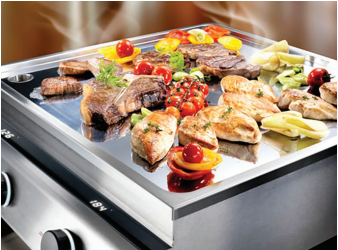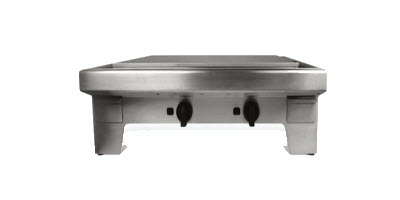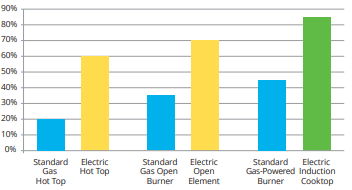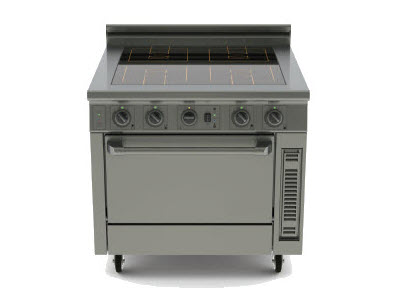
With advancements in induction cooking technology, induction ranges are now able to cook faster and with greater control than ever before. Offering easier cleanup, menu flexibility, and enhanced efficiency, induction ranges make a great addition to commercial kitchens, and even suit mobile cooking needs with portable units.
How Does Induction Cooking Work?
Induction cookers produce an alternating magnetic field using a copper coil that is fed current at a specified frequency and power level. When a steel vessel is placed in close proximity, an electric current is ‘induced’ in the steel. Heat is produced due to the resistive quality of the metal against the induced current. When properly controlled, this method is capable of generating precise amounts of localized heat.
Improved Induction Technology Comes with New Features and Advantages
Faster | An induction range can send more energy into cookware faster than gas, traditional coil, or radiant electric range. This means reaching desired cooking temperatures or boiling water faster.
Immediate response | Cooking temperatures can be raised or lowered instantly. With no grate, coil, or radiant burner to heat, all energy goes directly into the cookware.
Accurate control | Digital controls allow setting an exact — and repeatable — amount of heat without having to judge a variable flickering flame.
Efficient | Just the cookware is heated. No energy is wasted heating the air around the pan.
Safer | Overall kitchen safety is improved. Without an open flame, accidental injuries or kitchen/grease fires are greatly reduced. Induction cooktops are also safer as they are free of gas-related dangers, such as gas leaks or gas line breaks
Easy to clean | Induction ranges have a smooth, easy-to-clean ceramic glass surface without grates, nooks, or crannies where grease and spills accumulate.
Cooler kitchen | Without an open flame, plus the direct application of energy into the cookware rather than the air, kitchens stay cool and working conditions are more comfortable.
.

Types of Commercial Induction Cooking Appliances
Induction appliances are available in various models and sizes to suit a variety of needs, from portable to heavy-duty, and front- to back-of-house needs.
- Cooktops
- Stock Pot Range
- Griddles and Planchas
- Braising Pans
- Holding and Serving Systems
- Woks


Typical Cooktop Efficiencies

For more information on SCE's Support and Services for Education and Testing of Energy Efficient Commercial Foodservice Technologies, visit www.sce.com/ftc.
Making the Switch to Induction Cooking
Induction cooktops and equipment can be found at any appliance or restaurant equipment store. You can test any of the equipment listed on the reverse at the Foodservice Technology Center (FTC) in Irwindale. You can TRY before you BUY at the center.
Induction Serving Systems Also Provide Great Benefits
- Allows food to be held at precise temperatures
- No water lines or drains required
- Reheat and hold functions
- Pan compensation
- Automatic stir notification and timer
- Dry pan detection
- Less heat to space
- Less labor associated with cleaning wells and crusted pans
- Safer than traditional warmers
Tips for Converting to Induction Cooking
Cookware | All iron pans work — cast iron skillets and all other iron including enamel or ceramic coated iron. Most stainless steel works, as does blue steel. Aluminum, copper, and glass work only if the manufacturer has added an iron or steel plate to the bottom. Check your pans by holding a magnet to the bottom. If a magnet sticks, the pan will work. Look for a cooktop that allows bridging two burners together to cook on a cast iron griddle.
Power source | One- or two-burner portable induction cooktops can be plugged into a regular 110-volt wall outlet. A full-size four or five-burner range with a power boost for the fastest boil requires a dedicated grounded 208/240-volt outlet with a 30- or 50-amp breaker. Check with a licensed electrician to make sure your wiring is ready to handle the load.
Safety | Look for a cooktop with a sensor that doesn’t allow the burner to be turned on unless it senses a pan and automatically turns off in a few seconds once the cookware is removed. This is a common feature now. Users with a pacemaker or similar device should consult a doctor.
Sources
http://www.garland-group.com/Products/Induction/Counter-top-Series/Cook-Top-Line
Frontier Energy - Electrification in the Foodservice Industry
Cindy Bailen and Tyler Wells, ”Induction cooking—here’s why you should make the switch” 10 May 2019, USA Today Reviewed.com https://www.reviewed.com/ovens/features/induction-101-better-cooking-through-science
Paul Hope, “Best Induction Cooktops From Consumer Reports’ Tests” 06 March 2019, Consumer Reports https://www.consumerreports.org/electric-cooktops/the-best-induction-cooktops
Nicholas Gerbis “How Induction Cooktops Work” 9 December 2009, HowStuffWorks.com. https://home.howstuffworks.com/induction-cooktops.htm
Lloyd Alter, “Piles of peer-reviewed research show how bad cooking with gas is for your health” 10 August 2018, Treehugger.com https://www.treehugger.com/green-architecture/piles-peer-reviewed-research-show-how-bad-cooking-gas-your-health.html
©2023 Southern California Edison. All rights reserved.


